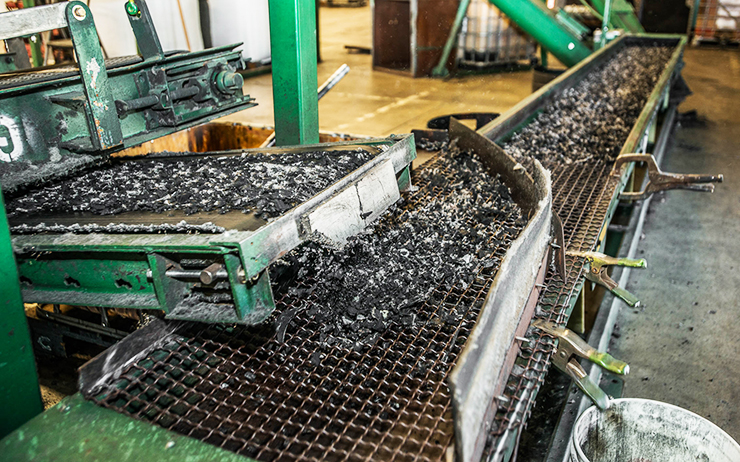With Shredded Tires, Pavement Is on a Roll
For the Fourth Straight Year, Caltrans Tops Its Crumb Rubber Requirements

For the fourth year in a row, Caltrans exceeded the state requirement for how much crumb rubber — derived from used tires — it used in laying asphalt pavement.
According to its 2018 Crumb Rubber Report, the most recent available, Caltrans used an average of 16.38 pounds of crumb rubber modifier (CRM) per metric ton of all asphalt pavement applied that year, exceeding the usage baseline at least 11.58 pounds of CRM per metric ton of asphalt set in 2013.
The presence of crumb rubber in hot-mix asphalt slows and minimizes the development of cracks and extends the service life of asphalt pavements.
With a few exceptions, Caltrans has steadily increased the percentage of asphalt containing CRM for its projects since 2007, when state usage requirements were established. The latest data from 2018 shows Caltrans’ CRM percentage at 46.4 percent, up from 45 percent in 2017 and 39.8 percent in 2016.
Use of CRM also diverts mountains of waste tires from being incinerated or clogging landfills. Caltrans estimates that in 2018, its consumption of crumb rubber diverted more than 5.5 million waste tires from landfills and tire stockpiles, 1 million more than the 4.5 million discarded tires diverted in 2017.

The total usage of asphalt containing CRM increased from 1.66 million metric tons in 2017 to 2.01 million metric tons in 2018, an increase of more than 21 percent. This increase was primarily due to increased usage of asphalt containing CRM in the pavement preservation and rehabilitation categories.
The report found that the initial cost per metric ton of asphalt containing crumb rubber varies between 4.2 percent less and 8.3 percent more than the cost of conventional asphalt, depending on the project category. Research has shown that asphalt pavement containing crumb rubber overlays are cost-effective when used to resist reflective cracking, which occurs when fractured concrete under asphalt contributes to the top layer cracking as well.
Caltrans will continue to use engineering and pavement expertise to determine when and where asphalt containing crumb rubber is placed. Caltrans has a process for life-cycle cost analysis for various pavement treatments, and the Division of Maintenance uses an annual pavement condition survey to update and refine this process.
During construction, exceptions to using asphalt containing crumb rubber may be considered because of factors such as the availability of asphalt concrete, constructability, environmental considerations and cost. Exceptions may cover the following situations:
- When hot mix asphalt project quantities are less than 1,000 metric tons, or staged construction operations require less than 1,000 metric tons per stage.
- When placed as a concrete pavement asphalt base.
- When the temperature is below 45 degrees Fahrenheit, when crumb rubber hardens and becomes difficult to apply.
- For roadways above 3,000 feet in elevation, where snow chains and truck traffic adversely affect the material’s performance.
- When placed as a bond breaker between the asphalt and concrete pavement layers.
- When the project has a Caltrans federal permit requirement for stormwater treatment best management practices.
Crumb rubber usage requirements have been adjusted upward since being first adopted in 2007. That year, Public Resources Code section 42703 began requiring Caltrans to meet a CRM goal of 20 percent for asphalt paving. From 2007 through the 2018 report, Caltrans exceeded the CRM goal in every year but 2013 and 2014, which corresponded with a time when the minimum goal was raised from 25 percent to its present 35 percent.
Source: Gurinderpal (Johnny) Bhullar, Pavement Reviewer, Caltrans Division of Maintenance.

